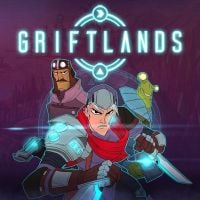You will also learn about the effects and synergies commonly used in Griftlands.
At the end we will provide info about several types of decks and explain the principle of their operation.
Cards
In Griftlands we have two separate decks.
One for negotiations and one for duels.
At the beginning of the game we receive a set of two basic decks.
you might see them when you start a new game.
Each deck has its own types of cards.
Each set has a different background color and an icon on the left side of the card name.
We distinguish the following groups of cards:
All cards have a rarity level.
These can be distinguished by the color of the frame.
The first are the Basic cards, which player gets in the beginning of the game.
Then you have Common, Uncommon, Rare and Unique cards at your disposal.
Each of these cards has unique and additional features.
In the right one you’re able to see the symbol of the deck to which it belongs.
This is especially useful when you choose one of the three cards to be included in your deck.
There is a damage interval in the middle of the card.
Under the picture you might see the name of the card.
To the left is the symbol of the group to which the card belongs.
Below you’re able to see the experience bar of the card.
At the bottom there is a space in which card features are described.
When you move your cursor over bold phrases, you’re free to check the additional information.
An important issue is the possibility of acquiring new cards.
At the beginning of the game you receive them for completing tasks and for winning duels or negotiations.
In the evening, at the end of the first day, you get access to the Roadsite market.
you could buy negotiation cards, duel cards and graphs to your armor.
That’s what Grafts are for.
They allow you to earn bonuses in negotiations or during a fight.
Like cards, they have different degrees of rarity.
For example, there are 3 Grafts below.
The last “Calamity Jar” gives you an extra action point per turn in duels.

In return, you’re free to’t have an animal to help you in fight.
Grafts can be easily distinguished by the color of the frame.
The orange color refers to the duels, just like the cards in the Attack group.
And the purple frame means that this Grafts are used in negotiations.
Just like the negotiation cards from the Manipulate group.
Also, during duels or negotiations Grafts are displayed at the top of the screen.
So you’re able to monitor their current effects on an ongoing basis.
Another aspect is getting these improvements to the armor.
There are a few options how you could get them.
The easiest way to get them is to complete quests and fight bosses.
We can also buy them from shopkeepers.
When you travel on the map there is a chance of a random event occurring.
One of them is an event when you meet a trader who has some Grafts in his offer.
Another way is to buy them on the Roadside Market from Plock “The Swab”.
If you want to get a discount on their purchase it is worth to do its job.
This will give you access to the market and a special offer to buy Grafts.
At the beginning of each game you get 2 basic decks, to negotiate and to fight.
Then, as the game progresses, you gain new cards and improve the existing ones.
It is worth noting here that you do not always have to match the card to your deck.
In return, you’re able to get 10 shills.
This is a rather poor reward, but sometimes it is better not to choose a redundant card.
A good deck should not have too many cards.
There are two types of negotiation deck.
The first one depends on using Diplomacy cards, those with a green background.
The second one is based on Hostility cards, red background.
This division originates from the evolution of the basic card which is “Sal’s Instincts”.
It has 2 stunts that work well with one of the two sets of cards.
Because of this card it is good to decide which style you want to play from the very beginning.
I can see from experience that both decks work well as long as you have good cards.
Also, remember not to stuff and overload the decks with unnecessary cards.
However, if you have any card you want to get rid of, you have 3 options.
The first is to remove it for a fee on the Roadside Market.
The basic fee is 50 shils, but it may be different because of our relationship with the seller.
Another option is to remove the card in the form of payment for the task.
After completing it you might choose from which deck you want to remove one card.
One of these evolutions may be a possibility to destroy it after it’s been played.
This is particularly common for cards in the basic set.
At the beginning I used it for Hostility group cards myself, building a deck from Diplomacy cards.
The first deck consists in earning Influence points that enhances cards in this group to deal maximum damage.
These points reinforce your cards from the Diplomacy group too.
The second one is to gain Domination points, which add one point of damage to Hostility group cards.
Things are different for duel decks.
It’s about Attack cards, which have Combo or Bleed in their description.
They are also used to deal large amounts of damage with Finisher cards.
The second deck uses the Bleed points inflicted to your opponent.
This site is not associated with and/or endorsed by the Klei Entertainment or Klei Entertainment.
All logos and images are copyrighted by their respective owners.